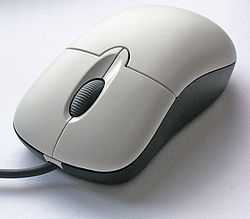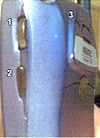Scroll wheel

A scroll wheel (or mouse wheel) is a hard plastic or rubbery disc (the "wheel") on a computer mouse that is perpendicular to the mouse surface. It is normally located between the left and right mouse buttons.
Functionality
It is used, as the name suggests, for scrolling. It can often also be used as a third mouse button by pressing on it. Some modern mice can scroll horizontally as well as vertically, using a tilting scroll-wheel (introduced by Microsoft), scroll ball (found, for example, on Apple's Mighty Mouse), pointing stick, or a second scroll wheel. Logitech mice with 'Free Spinning' scroll wheels use a 14 gram scroll wheel with high rotational inertia like a flywheel that can be used to quickly scroll through long pages and lists.[1]

Scroll wheels are prevalent on modern computer mice. To many users, they have become an integral part of the hardware interface. However, non-wheeled mice are still available.
Scroll wheels can also be found on such handheld devices as portable digital audio players, PDAs, or mobiles phones such as early Sony models and BlackBerry devices. On the Apple iPod, the scroll wheel uses touch sensitive technologies from Synaptics (instead of being mechanical).
History
In 1985 NTT, Japan and ETH Zürich, Switzerland (Kunio Ohno, Ken'ichi Fukaya and Jürg Nievergelt) jointly invented and developed the first scrolling mouse. Their Mighty Mouse had the scroll wheel accessible on the side.[2] Between 1989 and 1993 Daniel S. Venolia of Apple developed another mouse prototype with a thumb-wheel accessible on the side;[2] it was filed for patent in 1992 as U.S. Patent 5,313,230. It was granted in 1994.
In 1995, the Taiwanese company KYE Systems released the first commercial mouse with scroll wheel, and also the first with the scroll wheel located at the top. It was named Genius EasyScroll and was also available as Mouse Systems ProAgio.[3][4][5]
The scroll wheel was popularized by the Microsoft IntelliMouse in 1996 along with support for the mouse wheel in Microsoft Office 97. It was based on ideas developed by Eric Michelman since 1993 with input from Chris Graham.[6][7] In 1997 Microsoft filed the U.S. Patent 5,912,661, granted in 1999, for a mouse with a combined button and scroll wheel.
The introduction of the scroll wheel is notably one of the first additions to the basic two-button mouse design used for PCs that became a de facto standard. Its popularity increased with the proliferation of the World Wide Web, where efficient mouse-only scrolling is most useful, since it allows the mouse pointer to remain close to the page's hyperlinks while scrolling rather than moving to a scroll bar.
In the 21st century, scroll wheels started appearing on keyboards as well, particularly on Logitech and Microsoft models. It is usually located to the left of the caps lock key. The implementation of scroll wheels on laptop computers has generally faded, while touchpads are often made with the edges acting to scroll the page (rather than to move the pointer), partly making up for the lack of a scroll wheel. On laptops with multitouch capability, scrolling is usually achieved by touching and dragging two fingers on the touchpad at the same time. Many Linux distributions offer a third method of scrolling using the touchpad, where the user will first activate scroll-mode by pressing in a corner of the pad, and than dragging in a circle around the center of the pad, letting go of the touchpad will switch back to the default mouse-mode.
Other applications
In many applications (e.g. web browsers), holding down the control key while rolling the scroll wheel causes the text size to increase or decrease, or an image in an image-editing or map-viewing program to zoom in or out, if such a feature is available. Also clicking the link with a scroll wheel button makes the link open in a new tab, and clicking on the opened tab closes it.
In many first-person shooter (FPS) games, the scroll wheel is usually set to change weapons. Because of this some gaming mice, such as Logitech G500, implement a locking feature that lets the mouse switch between scrolling in steps (needed for gaming) and continuous scrolling (good for web browsing). The scroll wheel is also sometimes used to control the zoom of scoped weapons and binoculars. FPS games with an emphasis on realism may choose to use the wheel for changing between stances or adjusting the range settings on iron sights. Since the introduction of tilting scroll-wheels, many FPS games use the left-right motion of the scroll wheel to cause the player to lean left and right. A less common use is to use the mouse wheel to adjust the player's speed of movement.
Real time strategy games use the mouse wheel to change the altitude of the camera. Many RTS games also allow control of the camera with the scroll wheel button held down causing the view to either tilt or pan with mouse movement.
CAD applications such as AutoDesk's AutoCAD use the mouse wheel to navigate the space in which the user is drawing. This has also become a de facto standard in 3D applications such as Trimble's SketchUp where the wheelclick with a mouse drag is orbit and wheelscroll zoom.
See also
References
- ↑ Logitech.com
- ↑ 2.0 2.1 billbuxton.com – Input Devices: An Illustrated Tour, 2011-03-21
- ↑ topdesignmag.com – Mouse History In Photos
- ↑ funtrivia.com – Quiet As a Mouse – Fun Facts, Questions, Answers, Information
- ↑ Joe Kissell (October 7, 2004, updated 2006). "The Evolution of Scrolling: Reinventing the wheel". Interesting Thing of the Day. Retrieved 2010-02-12. Check date values in:
|date=(help) - ↑ Coding Horror: Meet The Inventor of the Mouse Wheel
- ↑ The History of the Scroll Wheel